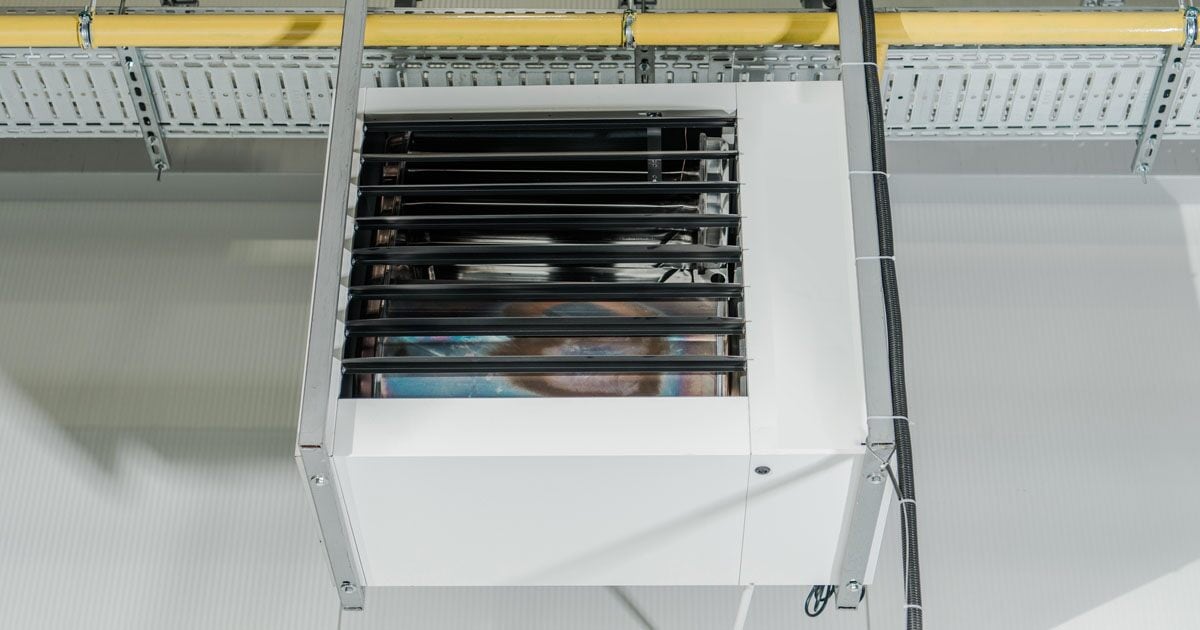
How to Heat a Garage
Garage Heating Options

It’s time to reclaim your garage! Think of all the possibilities that heating a garage opens. From woodworking, to auto maintenance, to poker nights, a heated garage can brighten up these often cold, gloomy months.
I’ll show you how to heat a garage in winter using a few different options, including garage heat pumps, and unit heaters. I'll also recommend what not to do. You’ll feel like you’ve added an entire extra room to your house.
The Best Way to Heat a Garage
For home garages, we recommend one of the following: unit heaters, ductless heat pumps, or wall furnaces.
Unit Heaters
One of the best ways to heat your garage in any climate is by using a unit heater, which is a permanently-installed, self-contained unit that blows hot air into the room. You may have seen one in supermarkets, skating rinks, or warehouses on a larger scale.
Unit heaters can provide between 24,000 BTUs of heat to more than 900,000 BTUs, depending on the model. The average home garage will need anywhere between 35,000 and 100,000 BTUs, but you should always get professional sizing.
Besides heat output, unit heaters also come in a large variety of fuel types that include gas, electric, and even hydronic models that connect to your boiler. They are typically installed either mounted to or suspended from the ceiling. Some can be mounted out-of-sight or blended with your garage’s existing aesthetic. There’s truly a unit heater for everyone.
If you’re interested in learning more about unit heaters, check out our unit heater buyer’s guide.
Wall Furnaces
A low-profile alternative to a unit heater, a wall furnace can be purchased in electric, liquid propane, and natural gas models.
As their name implies, wall furnaces mount on the wall and vent straight out, making for a more flexible installation. Although less efficient than unit heaters, wall furnaces are less obtrusive and a great option when you lack ceiling space.
Choosing between a unit heater and a wall furnace will come down to your individual garage. If you have a large garage with an open ceiling, then a unit heater will likely work best. A small, cramped garage with bike racks covering the ceiling may work better with a wall furnace.
Ductless Heat Pumps
A ductless heat pump, also known as a mini split, utilizes inverter technology and consists of an outdoor and indoor unit, and is typically the most energy-efficient way to heat and cool a garage.
At the most basic level, a heat pump collects outdoor heat and moves it inside your garage so you feel warm. Heat pump mini splits can also be reversed during summer to provide air conditioning to your garage, so it’s the best of both worlds.
You might be wondering how heat pumps collect outdoor heat if it’s winter. Well, there’s always some heat in the air, even if it feels cold. Ductless heat pumps can collect this residual heat, compress it (which makes it hotter), and effectively warm your garage.
Ductless heat pumps are extremely efficient because you’re not burning any fuel to get heat. They do require electricity to run the compressor, however. As a result, they could get expensive to run in areas where electricity costs are high.
Modern ductless heat pumps can work in temperatures as low as 10 degrees Fahrenheit or less. That being said, the efficiency and heat quality at those temperatures will be lower. If you live in an area where temperatures regularly plummet into the teens, you’ll probably want to go with a unit heater or wall furnace.
Other Garage Heating Options
There are other garage heating options that can work well in certain instances.
One example is radiant heat, which involves running either electric tubing or hot water piping under your garage floor. Radiant provides extremely comfortable heat (especially for your feet), perfect if you're either building a new garage or replacing the floor in an existing one.
Another option is an infrared heater, which provides intense infrared heat and can be a great option for larger home garages and commercial applications. However, infrared may be more than you need in a small, one- or two-car garage. Check with an installer to see if infrared can work for you.
The Problem with Portable Heaters
Unfortunately, you often get what you pay for with portable heaters. For one, you might not get the heat output you need out of these smaller units. Furthermore, because these are portable, you always need to be thinking about replacing the fuel tank, typically propane. That’s no fun if you intend to use your garage a lot.
But the most troubling reality of portable heaters involves the pollutants they release. Part of the reason portable heaters are cheaper to install is because their exhaust is not vented. Instead, they release carbon dioxide, carbon monoxide, nitrogen dioxide, and water vapor directly into the room they’re heating. They also carry a fire risk, especially near common garage combustibles like gas cans, paint, solvents, etc.
On the other hand, unit heaters and wall furnaces vent exhaust directly outside, so you never risk breathing it in. Electric heaters and heat pumps use electricity, so venting doesn’t apply.
Reclaim Your Garage
With such great heating options available, there's no need for your garage hobbies to go dormant during the winter. Unit heaters, wall furnaces, heat pumps, and even radiant or infrared heat can effectively thaw your garage into usable space.
If you have more questions about how to keep a garage warm during winter, please call to speak with one of our product experts at 1 (866) 554-4328.
